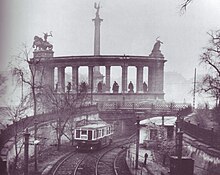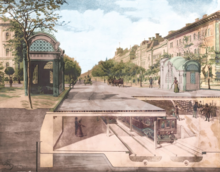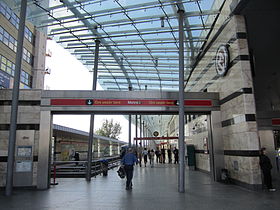Budapest Metro
This article needs additional citations for verification. (January 2016) |
The Budapest Metro (Template:Lang-hu) is the rapid transit system in the Hungarian capital Budapest. It is the oldest electrified underground railway system on the European continent, and the second -oldest electrically operated underground railway in the world, predated only by the 1890 City & South London Railway (now part of the London Underground) [6][7] Its iconic Line 1, completed in 1896, was declared a World Heritage Site in 2002.[8][9]
History



The first metro line was conceived as a means of carrying passengers from the city centre to the City Park without the need for surface transport on Andrássy Avenue. The Diet of Hungary approved the metro project in 1870. Construction began in 1894 and was carried out by the German firm Siemens & Halske AG, employing 2,000 workers using state-of-the-art machinery. The line was built entirely from the surface using the cut-and-cover method. [citation needed]
This original metro line followed a northeast-southwest route along Andrássy Avenue from Vörösmarty Square, in the centre of the city, to the City Park and Zoo (Széchenyi fürdõ), a distance of 3.7 kilometres (2.3 mi).[10] There were a total of eleven stations on the line, with nine underground and two above-ground; the original terminus at the Zoo has since been supplanted (by Mexikói út station, further to the northeast, in 1973). With trains running every two minutes, the line was then capable of carrying up to 35,000 passengers per day. One of the original Budapest Metro cars has been preserved at the Seashore Trolley Museum. [citation needed] Original carriages can also be seen in the Underground Railway Museum at Deák Ferenc tér station[11]
Plans for the next two metro lines were made as early as 1895, defining general north-south and east-west routes. More detailed planning for the second line began in 1942 and construction was launched in 1950 with a decree from the Council of Ministers. The line was originally scheduled for completion in 1955, but construction was put on hold for financial and political reasons from 1954 to 1963. Line 2 was built with help of soviet specialists and finally opened with seven stations on April 4 (a Communist holiday) in 1970. It follows an east-west route, connecting the major Keleti (Eastern) and Déli (Southern) railway stations. It has a joint station with the original line at Deák Ferenc Square, which has since become a transfer point for the third line as well. Before the opening of Line 4 in 2014, Line 2 was the only line to cross the Danube and reach Buda, the western part of Budapest. Since 28 March 2014, Line 4 also crosses the Danube reaching the most populous district of Budapest (district 11).[citation needed]
The first line underwent a thorough refurbishment between 1970 and 1973, which included replacement of its rolling stock and a switch from left-hand drive to right-hand drive for the sake of consistency. In 1973, both lines were extended—the first with one station and the second with four. The lines reached their current lengths of 4.4 kilometres (2.7 mi) and 10.3 kilometres (6.4 mi), respectively. The Budapest Transport Company (BKV) took over operation of the metro that same year.[citation needed]
Planning for Line 3 began in 1963 and construction started in 1970 with help of soviet specialists. The first section, consisting of six stations, opened in 1976. It was extended to the south in 1980 with five additional stations, and to the north in 1981, 1984, and 1990, with nine additional stations. With a length of approximately 16 kilometres (9.9 mi) and a total of 20 stations, it is the longest line in Budapest.
Concurrently with the opening of Line 3, the metro adopted a colour-coding scheme for easier identification. The first line was given the colour yellow, the second line red, and the third, blue. Additionally, green is used to mark the suburban railways (HÉV) in and around Budapest.[citation needed]
In the 1980s and 1990s, Line 1 underwent major reconstruction. Of its 11 stations, eight are original and three were added during reconstruction. The original appearance of the old stations has been preserved, and each station feature displays of historical photographs and information. There is also a Millennium Underground Museum in the Deák Ferenc Square concourse.[citation needed]
Line 4 has a long history, dating back to 1972. In the planning phase, difficulties arose from the medicinal springs (for example, the Gellért Baths) around its planned route. There was a long debate over whether its construction would be safe, what part should be funded by the government and the capital, whether it could be paid for from the Russian state debt towards Hungary, whether the route and length were appropriate, and whether a connector line (see M5 below) would be a better use of funds. When the Line 4 was finished in 2014, its planning and construction spanned 42 years, longer than any other Budapest metro line.[citation needed]
Overview
The Metro consists of four lines, each designated by a number and a colour. Line 1 runs northeast from the Pest city center to City Park along Andrássy Avenue. Line 2 runs generally east to west from the transit hub Örs vezér tere on the city's east side, and provides a connection between Keleti railway terminal and Déli railway terminal through the city center. Line 3 runs northwest from the transit hub Kőbánya-Kispest in the city's southeast, along Üllői út to the city center, and then north to the district of Újpest. Line 4 runs southwest to northeast from the transit hub of Budapest Kelenföld railway station in the city's most populous district of Újbuda across the inner city district of Józsefváros to Keleti railway terminal.
Lnes 1–3 converge at Deák Ferenc tér in the city centre, which was long the system's only transfer station. This bottleneck has been remedied by the opening of Line 4, which crosses Line 2 and Line 3 at different stations. The Metro forms a partially separate system from the Budapest HÉV commuter rail, though Line 2 of the Metro provides transfers to the termini of two of the four HÉV lines. Integration of the incompatible HÉV system into the Metro is a long-term goal, and forms the basis of the proposed Line 5.Except for short stretches near the depots of each line, the system is mostly underground.
Lines and developments

| Line | Color | Route | Length | Stations | Opened |
|---|---|---|---|---|---|
| Yellow | Vörösmarty tér ↔ Mexikói út | 4.4 km (3 mi)[1][12] | 11 | 1896 | |
| Red | Déli pályaudvar ↔ Örs vezér tere | 10.3 km (6 mi)[1][13][14] | 11 | 1970 | |
| Blue | Újpest-Központ ↔ Kőbánya-Kispest | 16.5 km (10 mi)[15] | 20 | 1976 | |
| Green | Kelenföld vasútállomás ↔ Keleti pályaudvar | 7.4 km (5 mi)[4] | 10 | 2014 | |
| TOTAL | 38.6 km (24 mi)[Note 1] | 52 | |||
Yellow Line 1

Line 1 runs northeast from the city center on the Pest side under Andrássy út to the Városliget, or City Park. Like Metro 3, it does not serve Buda. Line 1, the oldest of the metro lines operating in Budapest, has been in constant operation since 1896.
Red Line 2
Line 2 has undergone major reconstruction, with all of the track and stations completed in 2008. Blaha Lujza tér and Kossuth Lajos tér were renovated in 2004; Batthyány tér, Astoria, and Keleti pályaudvar in 2005; and Déli pályaudvar, Moszkva tér (Name restored to Széll Kálman tér on 12 May 2011), and Deák Ferenc tér in 2006. Elevators will be installed at Kossuth Lajos tér, Blaha Lujza tér, Keleti pályaudvar, and Astoria. The old Soviet trains have been replaced with new air-conditioned Alstom Metropolis carriages by 2013. Recently, the Urban and Suburban Transit Association (Városi és Elővárosi Közlekedési Egyesület) presented a plan to unite Line 2 with the HÉV from Gödöllő. The city government did not totally support the plan, but it still may proceed after 2015. [citation needed]
Blue Line 3

Line 3 runs in a north-south direction (more exactly, from north-northeast to southeast) through the city and connects several populous microraion with the downtown.[16] It has a transfer station with Line 1 and Line 2 at Deák Ferenc tér, and a transfer station for Line 4 at Kálvin tér. It is the longest line in the Budapest Metro, its daily ridership is estimated exactly at 626,179. [citation needed]
Green Line 4

Line 4 connects Kelenföldi Station and Keleti Railway Station, and has a length of 7.4 kilometres (4.6 mi). It was completed in March 2014, and comprises ten stations.[17]
The construction of the second section (with four stations) between Eastern Railway Station and Bosnyák Square, with a length of 3 kilometres (1.9 mi), is not started yet, and unlikely to start before 2020. [citation needed]
In 2005 construction work began at Baross square, the square in front of the Eastern Railway Station. A new station exit and underpass were constructed, connecting the existing Line 2 station to the surface in the area of the parking lot. The new exit is needed to meet the significant increase in traffic demand expected in the future (an additional 600,000 passengers per day are expected to use the new line). The new exit will also enable the currently operating exit to be closed during construction of the new station. Work was completed by December 2005. [citation needed]
Purple Line 5

The proposal for Purple Line 5 is for a rapid rail system which will include the Budapest-Esztergom heavy railway line. The Csepel and Ráckeve HÉV lines will be connected on the surface, near the National Theatre. In Boráros Square, the metro goes underground, and at Kálvin Square it crosses Metro line 3 and line 4. At Astoria the line crosses line 2. The rail heads to Oktogon, and crosses line 1. Finally, at Lehel tér, the line again crosses Metro line 3 before heading to Margaret Island and Buda side. The plan is modelled on the Paris RER or German S-Bahn systems. There is no determined exact start date, but it's among the city's highlighted projects. [citation needed]
General information
Tickets and transfer system
The implementation of latest generation automated fare collection and e-ticket system with NFC compatibility and reusable contactless smart cards for making electronic payments in online and offline systems in Budapest is started in 2014, the project is implemented and operated by the operator of Hong Kong Octopus card jointly with one of the leading European companies of e-ticket and automated fare collection, Scheidt & Bachmann.[18] The deployment of 300 new digital contactless ticket vending machine mainly at the metro stations, will be finished by the end of 2014 in harmonization with the e-ticket system.[19]
Hours of operation
Lines run from approximately 4:30AM until 11:30PM every day, though times vary slightly between lines.[20]
Current Fleet
The Budapest Metro is completely electrified and standard gauge in operation. Three different types of rolling stock are currently in service:
| Lines | Train-type | Image | Description |
|---|---|---|---|
| Line 1 | Ganz Works | 
|
3-car articulated-units locally built by Ganz Works. The sets are specifically designed for the unusual loading gauge determined by the shallow tunnel. |
| Line 2 | AM5-M2 | 
|
Alstom Metropolis, 5-car sets. A trainset is structured as A-B-C-B-A, where the A-B cars are motor cars forming a single electronic unit and coupled semi-permanently, with a C-type trailer car in between the two A-B units. |
| Line 3 | 81-717/714 | 
|
Soviet-made motor cars forming sets of 6. The first and last cars, equipped with control cabs, are of the type 81-717. The four middle motor cars are of the cabless type 81-714. This type also appears in many metros in the former Eastern Bloc. |
| Ev3 | Soviet-made motor cars forming sets of 6. Although all have a driver's cab, only the designated head cars are equipped with the automatic train control system AVR. | ||
| Line 4 | AM4-M4 | 
|
Alstom Metropolis, 4 unit car sets structured as A-B-B-A, where the A-B cars are motor cars forming a single electronic unit and coupled semi-permanently. |
See also
- Trams in Budapest
- Public transportation in Budapest
- List of metro systems
- List of automated urban metro subway systems
Notes
- ^ The total length listed here does not match the total given in the Infobox due to difference in how the line lengths are calculated, and the references used. In general, it is assumed that the figure given in the Infobox is the more accurate figure for the system's total route length.
References
- ^ a b c Mátyás Jangel (September 2010). "Közszolgáltatási szerződés, utasjogok, a szolgáltatástervezés és ellenőrzés folyamata a kötöttpályás helyi- és elővárosi közforgalmú közlekedésben" (pdf) (in Hungarian). BKV Zrt. Közlekedési Igazgatóság [Directorate of Public Office. Transport]. pp. 10 (and 3). Retrieved 2015-04-19.
{{cite web}}: Unknown parameter|trans_title=ignored (|trans-title=suggested) (help) Metro usage per day – Line 1: 120,000; Line 2: 405,000; Line 3: 630,000. (Line 4 began operations in 2014, with a 110,000 ridership estimated by Centre for Budapest Transport (BKK) based on the latest year.) - ^ "Annual Report 2011" (pdf). BKV Zrt. 2011. p. 4. Retrieved 2013-10-06.
- ^ "Annual Report 2011" (pdf). BKV Zrt. 2011. p. 48. Retrieved 2013-10-06.
- ^ a b "New Surface Transport Network Following Start of Metro Line 4 on 29 March 2014". bkk.hu. 28 March 2014. Retrieved 2014-03-30.
- ^ Siemens.com Budapest Line 4 Archived 2015-01-28 at the Wayback Machine
- ^ Electric Railway Society (2003). https://books.google.co.uk/books?id=9DdeAAAAIAAJ&redir_esc=y. Doppler Press. p. 61. Retrieved 29 August 2012.
- ^ . Kogan Page: Europe Review 2003/2004, fifth edition, Wolden Publishing Ltd, 2003, page 174 [1]
- ^ UNESCO Template:WebCite
- ^ "Our thematic route with... - Sightseeing along the line of Millennium Underground Railway". BKV Zrt. Retrieved 2013-10-18.
- ^ "Budapest". UrbanRail.net. Retrieved 2014-05-30.
- ^ http://www.budapestbylocals.com/budapest-museums.html
- ^ "Az M1 Millenniumi Földalatti..." (pdf) (in Hungarian). Budapesti Közlekedési Központ. 2012. p. 6. Retrieved 2014-04-02.
- ^ "2-es metróvonal jellemzői" (in Hungarian). Retrieved 2014-04-02.
- ^ Árpád Bodnár: A budapesti metró két évtizede ("Two decades of the Budapest Metro"), Városi Közlekedés, Year XXXI, Vol. 3, pp. 119-121, Budapest, 1991
- ^ András Koós - Tamás Szirmay - Jenő Tiborcz: A budapesti 3-as metróvonal új szakasza ("The new section of Budapest Metro Line 3"), Városi Közlekedés, Year XXXI, Vol. 1, pp. 126-127, Budapest, 1991.
- ^ Budapest City Atlas, Dimap-Szarvas, Budapest, 2011, ISBN 978-963-03-9124-5
- ^ "Automated metro Line M4 opens in Budapest". Railway Gazette. 28 March 2014. Retrieved 9 April 2015.
- ^ "Budapest signed the Contract Agreement for the Automated Fare Collection system". BKK Zrt. 8 October 2014. Retrieved 24 October 2014.
- ^ "Purchase your ticket easier". BKK Zrt. 17 July 2014. Retrieved 24 October 2014.
- ^ Timetables




